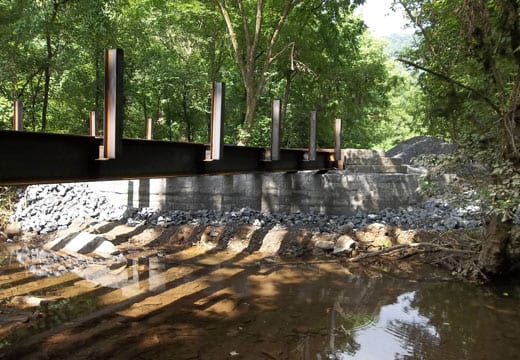
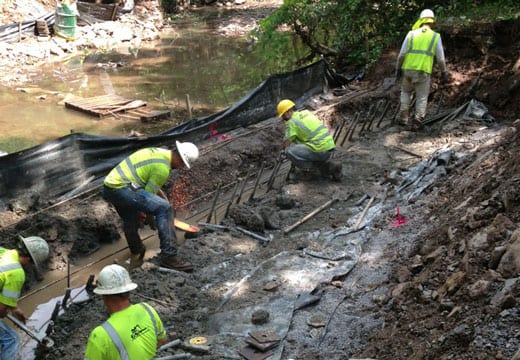
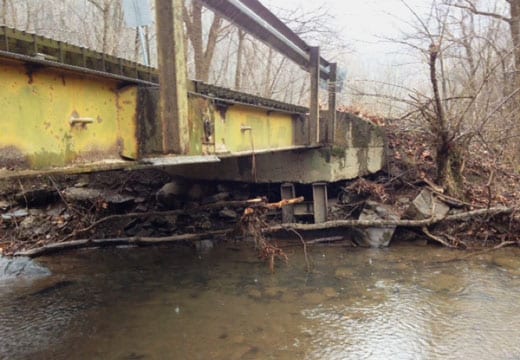
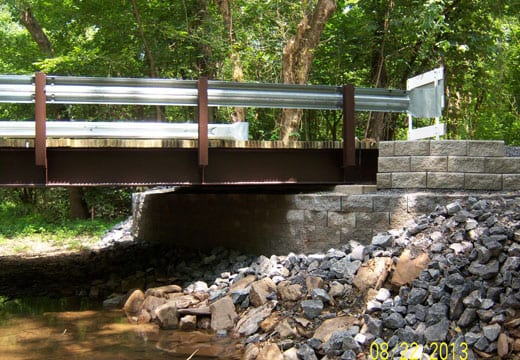
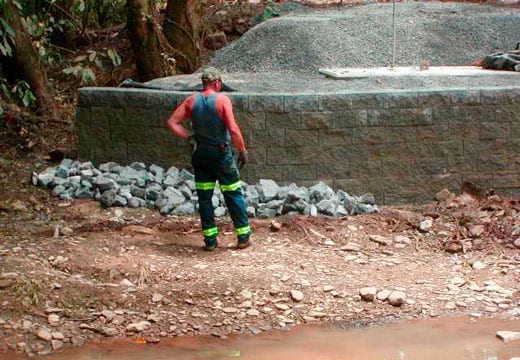
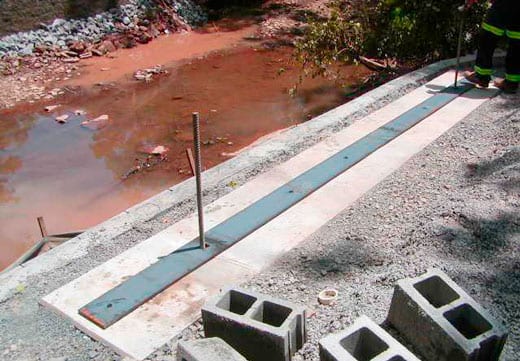






When a limited access bridge needs to replacement or repair, the people in charge of the project have a lot to think about. From environmental impacts to updated design standards, the world of bridge replacement and repair is vast. GeoStabilization International® specializes in all forms of geohazard mitigation services, from slope protection to landslide repair. Bridge replacement is one of the primary services offered by GeoStabilization.
At this limited access site nestled in the Appalachian Mountain region, an existing bridge was in disrepair due to the dwindling local DOT budget. The bridge spanned a drainage runoff that flows into one of the nation’s American Heritage Rivers, the New River. Access to the site is only achieved by two track dirt roads from each end. In order to bypass the bridge, an hour detour on the dirt two-track roads was necessary to get to the other side.
The existing bridge was in disrepair and needed to be retrofitted or replaced. The construction methods used in the original design did not meet current design standards; the only option was a complete replacement. Due to the limited site access, the replacement options were limited. Typical bridge replacements are completed using precast concrete structures. This was not an option due to the limited access to each end of the bridge.
The water level in the drainage also varied depending on the time of year and weather. This created a problem with the stability of the structure since water would often flow in both directions through the drainage. When a downriver dam would adjust for varying water levels in the New River, the drainage would back up with water and create an uplift phenomenon. Due to the dynamic forces involved with this particular site, new technologies were explored to resolve the complicated issues.
GeoStabilization provided a design option that could be constructed within the site limitations and DOT budget, would not require excavation to bedrock, and would not require excavation below the waterline. GSIAbutments™ paired with ScourMicropiles™ were designed and implemented to replace the existing bridge supports. Each abutment was constructed to match the existing bridge geometry, using reticulated Self-Drilling SuperNails™ for scour protection and GCS™ services & technology for the abutments. The total construction time for both GSIAbutments™ and ScourMicropiles™ was less than ten (10) working days.
The other issue was the change in water levels travelling both directions through the drainage. Since the flow of the drainage can vary +/-5 feet, a stable and composite structure was critical. The construction sequence required for the GSIAbutments™ allowed tie-down anchors to be placed through the GCS™ fill. Once the entire abutment was constructed, the tie-down anchors were bolted to the bridge superstructure to prevent uplift and horizontal displacement.
After the abutments were constructed, the local DOT maintenance forces completed the bridge superstructure with steel girders and bridge deck. In addition, the GSIAbutments™ prevented the “bump at the bridge” phenomena seen with bridges with rigid foundations.
Sometimes the choice between replacement and repair is clear-cut, as in the case of an outright failure. Other times, it can be murkier. Bridge construction and repair can be tricky business. Older bridges that do not hold up to modern design standards may legally need replacing, while historic bridges have concerns regarding preservation. A lot also depends on the condition of the existing bridge, from its abutments to its slabs.
One of our geohazard mitigation experts can help with this decision. Repair may be the superior option in some cases, while bridge replacement is best for others.
Limited access bridges have special concerns regarding bridge replacement. Naturally, access is the first item on the list. The geography of the road leading to the bridge may have as much of an impact on construction as the geography of the site itself. Are sturdier detours available? How long do they take to drive? Technologies such as GSIBRIDGE™ that use Geosynthetically Confined Soil™ can save project managers huge amounts of time and money in this regard.
In areas with limited access, ongoing maintenance is another important concern. Building a bridge that requires frequent upkeep from large equipment is not always a feasible option, and having a robust bridge superstructure from day one is paramount.
Building or replacing a bridge in a remote or poorly accessible area only adds to the expense involved. Mitigating the base cost of construction is also of critical concern. Modern bridge construction materials and methods can optimize the cost of replacing a limited access bridge.
Finally, remote areas tend to have unique geography. This can lead to a variety of complications that a geohazard mitigation specialist can help prevent. Soil nails, grouting, lightweight fill, and shotcrete may be necessary depending on the layout of the land. Climate is also a concern: the time to plan for erosion is before construction begins, not afterward.
GeoStabilization International® is the United States and Canada’s leading expert in limited access bridge replacement and repair. With more than twenty years of experience in bridge construction and repair, GeoStabilization provides services from landslide prevention to residential slope stabilization. Call us at 855-579-0536 to learn more about our geohazard mitigation services.
If you are interested in a no-obligation site visit to determine if our services fit your geohazard mitigation needs, call us at 855-579-0536 or fill out our contact form.